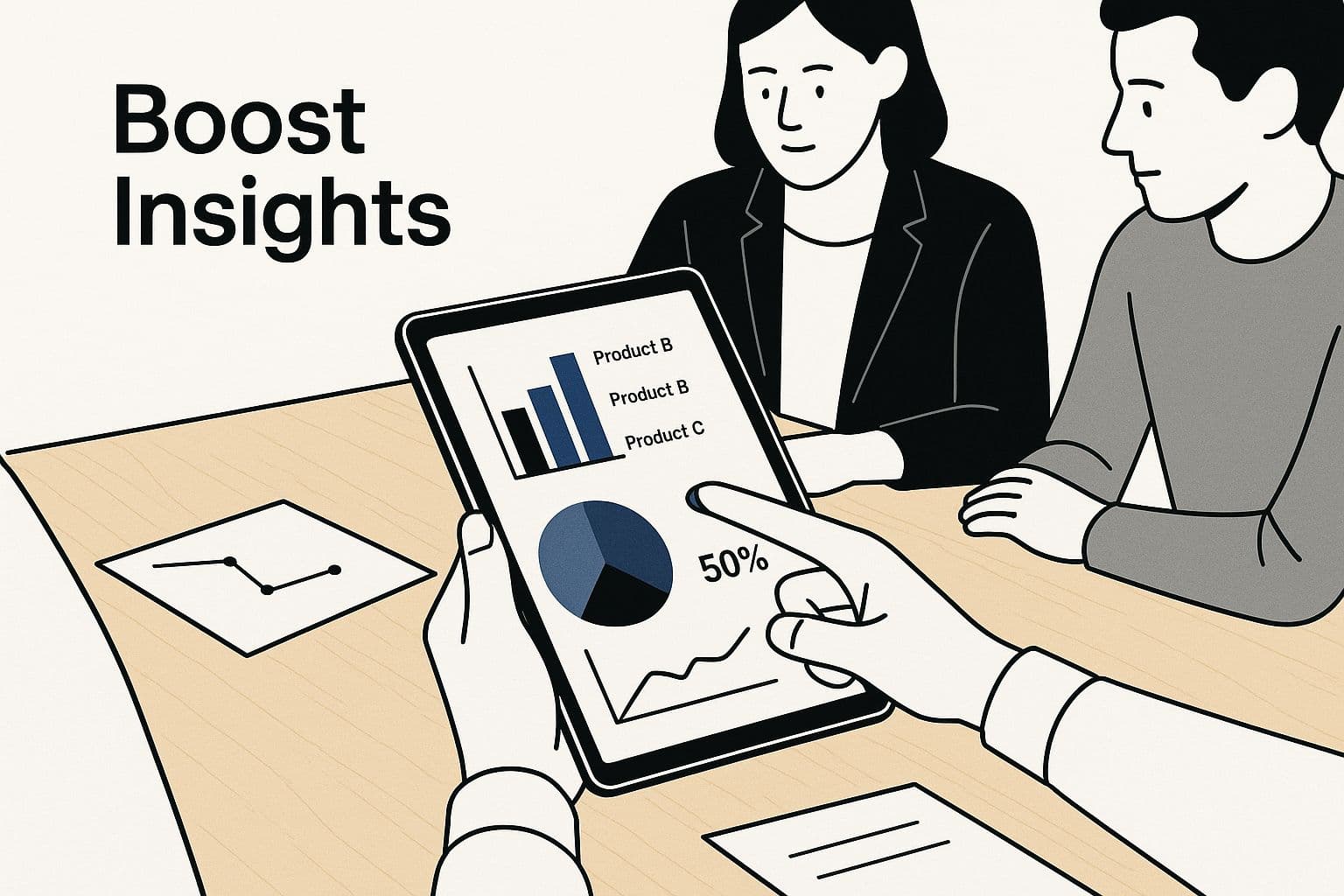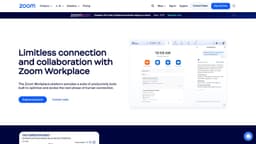Sales call recording software isn't just a playback tool anymore; it's become a powerhouse for driving revenue. Today’s platforms are built around conversation intelligence, digging into sales calls to pull out insights that help teams close more deals, make coaching more effective, and get new hires up to speed faster.
Why Call Recording Is Now a Must-Have Sales Tool
Remember when call recording was mostly for compliance checks or settling "he said, she said" arguments? Those days are long gone. The best sales teams now treat their call recordings as a goldmine of business intelligence. These systems do more than just store audio files—they transcribe and dissect every conversation, turning spoken words into usable data.
This is a huge leap from simply listening back to calls. Now, it’s all about strategic analysis. A manager can pinpoint the exact phrases and tactics that make their top reps successful and build a coaching plan around what’s proven to work, not just what they think works. It's this data-first approach that helps a team scale its wins.
Unlocking Actionable Insights
Modern platforms use AI to automatically flag important moments in a call, like when a competitor is mentioned, a specific objection comes up, or pricing is discussed. This transforms what would be a massive, unusable archive of audio into a searchable, strategic database.
For instance, this dashboard shows a typical interface for call recording software, giving you a clear look at how conversations are logged and organized for review.

This kind of setup allows leaders to spot trends, understand what the market is saying, and tweak their sales playbook based on real-time feedback from the front lines.
Fueling Business Growth
The ripple effect goes well beyond the sales team. The nuggets of information pulled from customer calls can shape marketing campaigns, steer product development, and sharpen the company's competitive edge. It's no surprise the market for these tools is booming.
This rapid growth signals a major shift in how businesses operate. More and more, companies are leaning on call analysis to stay competitive and efficient. You can learn more about the call recording software market trends to see what's behind this expansion. By truly listening to the voice of the customer, organizations can make smarter decisions that lead to real, sustainable growth.
What Features Actually Matter?
Choosing the right sales call recording software really boils down to what your team needs to get ahead. It’s tempting to get dazzled by a long list of features, but only a handful truly separate a simple recording tool from a platform that actively helps you close more deals. Let's be honest, just having a library of old calls isn't enough anymore.
The real game-changer is AI. Tools with powerful, AI-driven analytics are no longer a luxury; they're the new standard for any serious sales team. This tech does the heavy lifting for you, turning hours of recorded audio into clear, actionable insights that can shape your entire sales strategy.
AI Analytics: Your Secret Weapon
The biggest difference between a basic and a top-tier call recording tool is how it analyzes conversations. Instead of having a manager listen to calls for hours on end, AI can instantly pinpoint key moments, highlight trends, and show you what's really happening on the front lines. Your call archive transforms from a dusty old library into a live intelligence feed.
Here are the AI features that deliver the most bang for your buck:
- Sentiment Analysis: This is huge. The software can actually gauge the emotional tone of a call, flagging conversations where a customer is getting frustrated or a deal is starting to go south. It gives you a chance to jump in and save the day before it's too late.
- Topic Tracking: Imagine instantly knowing every time a competitor is mentioned, or when a pricing objection comes up. Topic tracking automatically tags these keywords, so you can see trends across hundreds of calls in just a few clicks.
- Action Item Detection: How often do reps forget to send that follow-up email? Smart software recognizes when a promise is made on a call and can create an automatic reminder or task. Nothing slips through the cracks.
With this kind of data, a sales leader can pull a report in seconds to see how often a new competitor was mentioned last month. That's real, hard data you can use to update your battle cards and coach your team.
Making It Part of Your Workflow
A tool is only as good as how well it fits into your daily routine. Seamless integration with your CRM, like Salesforce or HubSpot, isn't just a nice-to-have—it's essential. This connection ensures call recordings, transcripts, and highlights get logged automatically to the right customer account, creating one single source of truth for everyone.
You also want to look for features that make coaching and collaboration easy. The best platforms let managers leave comments at specific timestamps in a call transcript to give targeted, in-context feedback. You can even create playlists of your team's "greatest hits"—like the perfect discovery call or a masterclass in handling objections—to get new hires up to speed faster. Suddenly, every conversation becomes a valuable training moment.
Comparing the Leading Call Recording Platforms
Picking the right sales call recording software can be a real headache. The market is crowded, and on the surface, a lot of tools look the same. They all record, they all transcribe. But the real magic—the stuff that actually moves the needle on revenue—is in the details. You have to look past the basic feature lists to see how a platform’s analytics, user experience, and integrations fit into your actual sales process.
Let's cut through the noise and compare the big three: Gong, Chorus.ai (by ZoomInfo), and Fathom. I'll break down which one is built for enterprise-grade competitive analysis, which one is a coach's best friend for growing teams, and which is the no-fuss option for getting started. It's all about matching the tool to your team's real-world needs.
Gong: The Revenue Intelligence Titan
Gong has earned its reputation as the heavyweight in this space. It's not just a call recorder; it's a full-blown revenue intelligence engine designed to connect what’s said in customer conversations directly to business outcomes. Think of it as the brain of your sales organization.
Its biggest strength is its ability to chew through a massive amount of call data and spit out strategic insights. Gong’s AI is incredibly smart at understanding context. It doesn't just hear a competitor's name; it can tell you if it was a passing mention or a serious deal-breaker. That’s a huge difference.
This makes Gong a perfect match for:
- Big Enterprise Sales Teams: If you've got complex sales cycles and need to stay ahead of the competition, Gong delivers the market intelligence you need.
- Data-Obsessed Sales Leaders: For managers who live and breathe data, Gong connects the dots between sales activity and closed deals like nothing else.
- Companies in Cutthroat Markets: When you absolutely have to know what your competitors are doing and how the market is shifting, Gong gives you a real edge.
All that power comes with a hefty price tag, though. Gong is one of the most expensive tools out there, which puts it out of reach for many smaller businesses. It also has a bit of a learning curve; you have to put in the time to really get the most out of it.
Chorus.ai: The Coaching and Performance Accelerator
Chorus.ai, which is now part of ZoomInfo, carves out its own space by focusing squarely on sales coaching and team performance. While its analytics are powerful, the whole platform is geared toward making managers better coaches and reps better sellers. It's all about skill development and playbook consistency.
Where Chorus really shines is in making coaching a scalable, repeatable process. A manager can snip out the perfect example of a rep overcoming an objection, add it to a "greatest hits" playlist, and share it with the whole team for training. It’s simple to tag people, leave time-stamped feedback, and see if your reps are actually using the coaching you give them.

This kind of collaborative review, as shown above, is exactly what platforms like Chorus are built for—turning individual calls into teachable moments for everyone.
Chorus is the right call for:
- Mid-Market and SMB Sales Teams: Companies in a growth phase that need to onboard reps fast and make sure everyone is following the same winning playbook.
- Sales Enablement and Trainers: If your job is to get new hires ramped up and keep the tenured team sharp, Chorus is built for you.
- Teams with a Strong Coaching Culture: Organizations where feedback and peer learning are part of the DNA will get a ton of value here.
The deep integration with ZoomInfo’s B2B data is another big plus. It adds a rich layer of context to every call, helping reps walk into meetings better prepared. While still a serious investment, Chorus is generally a more budget-friendly option than Gong for mid-sized companies. If you're exploring other automated tools, our guide to Fireflies.ai and its capabilities is a great read on an alternative approach.
Fathom: The User-Friendly Note-Taker
Fathom plays a completely different game. It isn't trying to be a massive intelligence platform. Instead, it’s a super-efficient AI meeting assistant that’s laser-focused on one thing: killing the pain of manual note-taking.
Its beauty is in its simplicity. During a call, you just click a button to highlight a key moment. When the meeting ends, Fathom instantly generates a perfect summary with action items and links to the parts you highlighted. Post-call admin work that used to take 15 minutes now takes 15 seconds.
Fathom is a no-brainer for:
- Small Businesses and Startups: Teams that need a simple, often free way to record and summarize calls without a big budget.
- Individual Reps and Freelancers: Anyone looking to be more productive and organized without having to learn a complex new system.
- Teams Just Starting Out: If you want to see what call recording can do for you before signing a big contract, Fathom is the perfect entry point.
The trade-off here is depth. Fathom is all about the individual meeting, not big-picture analytics. It won't give you the market trends or competitive intel that Gong and Chorus do because that's just not what it's built for.
This boom in recording tools is part of a bigger shift. The call tracking and sales dialer software markets are exploding because analyzing voice conversations has become critical. As of 2024, the call tracking software market hit USD 8.84 billion and is expected to climb to USD 9.82 billion by 2025. It’s clear that companies are betting big on customer engagement analytics. You can find more call recording software statistics on blog.9cv9.com.
Feature Breakdown of Top Sales Call Recording Software
To make this even clearer, here's an at-a-glance evaluation of what makes each of these tools tick. This table breaks down their core capabilities, who they're really for, and what makes them stand out.
| Platform | Standout Feature | Ideal for Team Type | AI Analytics Focus | CRM Integration Depth |
|---|---|---|---|---|
| Gong | Proactive deal risk & pipeline intelligence | Enterprise & Large Mid-Market | Market trends, competitive analysis, and revenue outcomes | Deep, bi-directional sync, especially with Salesforce |
| Chorus.ai | Scalable coaching playlists & performance tracking | Mid-Market & High-Growth SMBs | Rep skill gaps, playbook adherence, and coaching moments | Strong, enhanced with ZoomInfo's B2B contact data |
| Fathom | Instant, one-click call summaries & highlights | Individuals & Small Teams | Note-taking automation and key moment extraction | Simple sync for notes, summaries, and action items |
Ultimately, there's no single "best" sales call recording software. The right choice comes down to your primary goal. Are you trying to outsmart the competition? Get Gong. Do you need to build an elite, well-coached sales team? Go with Chorus. Or do you just want to save time and be more organized? Fathom is your answer.
Getting Your New Software Off the Ground
Picking the right sales call recording software is a big win, but it’s really just the first step. The magic happens when your team actually uses the tool—not because they have to, but because they see it as a secret weapon for their own success. The key is to frame it as a tool for personal growth, not as a micromanagement gadget.
Think about it. When reps view call recordings as a way to coach themselves, pinpoint where they stumbled, and learn from the best reps on the team, they'll actually want to use it. The software stops being "big brother" and becomes their personal game-film library, helping them hone their skills and, most importantly, close more deals.
Setting the Stage for a Smooth Launch
A great rollout starts way before anyone hits the "record" button. The tech setup needs to be flawless. Nothing kills excitement faster than a clunky, frustrating first experience, so your goal is a smooth, easy start right out of the gate.
Here’s a practical checklist to get the technical side squared away:
- Nail the CRM Integration: Make sure the software syncs everything—recordings, transcripts, notes—to the right contacts and deals in your CRM automatically. This kills manual data entry and makes the tool a time-saver from day one.
- Sync Calendars and Meeting Tools: Connect the platform to your team’s calendars and tools like Zoom or Google Meet. This makes recording automatic, so reps don’t have to think about it.
- Define Your Keywords: Sit down with your team and figure out what to track. This could be competitor names, specific product features, or the usual objections. Customizing this early makes the AI insights relevant from the start.
- Set Up User Permissions: Decide who sees what. Managers might need access to their team’s calls for coaching, while reps should be able to review their own. Getting these permissions right helps maintain privacy and focus.
Once the tech is solid, you can turn your attention to the people—helping them build new habits and showing them how this software makes their jobs easier.
Building a Culture of Constant Improvement
With the software up and running, the next challenge is to weave it into your team’s DNA. This means you can't just let the recordings pile up. You have to actively use them for coaching, training, and planning. That’s how you’ll see a real return on your investment.
The demand for these tools is exploding for a reason. The call recording market is expected to jump from USD 1.5 billion in 2024 to around USD 3.2 billion by 2033. This isn't just about recording calls; it’s about having tools that help you understand and manage all those conversations. You can find more details about this expanding market on verifiedmarketreports.com.
These recordings will make your coaching sessions ten times better. Instead of giving generic advice, a manager can pull up a two-minute clip and say, "Listen to how Sarah handled that pricing question. Let's talk about why it was so effective." Suddenly, vague feedback becomes tangible, actionable advice. By making your new sales call recording software the heart of your coaching, you create a powerful feedback loop that lifts everyone's game.
Understanding Call Recording Laws and Compliance

Before you even think about hitting "record," we need to talk about the legal side of things. Bringing call recording software into your sales process means you have a serious responsibility to respect privacy and follow the law. Getting this wrong isn't just a slap on the wrist; it can lead to hefty fines and legal trouble.
The biggest hurdle, especially in the U.S., is the difference between one-party consent and two-party consent states. In one-party states, you just need permission from one person on the call to record—and that person can be you. But in two-party states, everyone on the line has to agree.
Because laws can get tangled quickly, especially if your sales team calls across state lines, the smartest and safest approach is to always act like you're in a two-party consent state.
Navigating Different Consent Laws
The rules for recording calls change drastically depending on where you and your customers are. This is why having a single, clear policy for your whole team is a must.
- One-Party Consent States: In states like Texas and New York, you're in the clear as long as one person (like your sales rep) knows the call is being recorded.
- Two-Party Consent States: But in places like California, Florida, and Pennsylvania, you need explicit permission from every single person on the call. You might also hear this called "all-party consent."
And that's just the U.S. If you deal with customers in Europe, you're looking at the General Data Protection Regulation (GDPR), which has even tighter rules. With GDPR, you need a solid legal reason for recording and must be completely transparent about how you'll use that data.
Practical Steps for Ensuring Compliance
Knowing the rules is one thing, but actually following them consistently is what counts. Thankfully, the best call recording tools often have features built right in to help you manage this automatically.
Here's a simple checklist to make sure you're always covered:
- Automated Disclosures: Set up a pre-recorded message that plays at the beginning of every call. Something simple like, "This call may be recorded for quality and training purposes," does the trick.
- Explicit Verbal Consent: Don't just rely on the automated message. Train your reps to ask for permission directly. A quick, "Are you comfortable with me recording this call?" is all it takes to get clear confirmation.
- Visual Cues in Video Calls: When recording video meetings, make sure the software clearly shows a persistent notification—like a red dot or a "Recording" banner—so everyone knows what's happening.
If you want to get into the nitty-gritty, we've put together a more detailed guide on security, privacy, and compliance. By building compliance into your workflow from day one, you can use call recording technology the right way—responsibly and ethically.
So, How Do You Choose the Right Tool for Your Sales Team?
Picking the right sales call recording software can feel overwhelming, but it gets a lot simpler when you boil it down to one question: What's our main objective?
Are you trying to get new hires up to speed faster? Are you hunting for a competitive edge by mining calls for market intelligence? Or is it simply about making your reps more efficient? Your answer is the compass that will point you to the right solution.


